
NOTE from Barb. For all those who have asked about the talks we gave in India last month, here you go! (Photos are © Jayalakshmi Ayyer & Janine Smith, all rights reserved)
A Decade of Travel, a Lifetime of Change
Our travels started more than forty years ago when my two roommates and I decided to leave the US from separate locations and meet up in Europe. To everyone’s shock, we pulled it off without cellphones, or even much money—mostly because we planned to meet up in Luxembourg, a country so small the odds in favor of chance street encounters were almost 100%, but also because one of us [cough Jaya cough]was carrying the BS, a blue suitcase so enormous it took up approximately a third of the country’s square footage and was visible on satellite images.
Flushed with success (not to mention mobile phones, better credit ratings, wheeled suitcases, and the ability to drink legally), Janine, Jaya, and I recklessly decided to repeat this feat four decades later.
Just to make it more interesting, this time we chose to visit India, where the odds against randomly linking up are approximately a bazillion to zip. Nobody who knew the three of us believed it when we actually managed to meet in the middle of India. So obviously, we just had to push our luck by continuing to meet every year. (Actually, that last bit nobody had any trouble believing.)
Thus for the better part of the past decade, my two old friends and I have traveled to India every January to explore a different part of an endless country. Like the rest of the world, all that stopped with the pandemic three years ago. All of a sudden, we were “vulnerable”, sheltering in place as Covid’s death toll reached into the millions. Like the rest of the world, we channelled our amazement at surviving into a determination to make the most of every precious day.
As we were planning our first post-Covid trip **, I wondered what changes we would find in India, both over our Covid absence, and over the past decade of our India travels.
**And by “planning” I mean of course, that we follow one simple rule: we do whatever Jaya says. So if anyone wants to know why we did or did not do something in India, the answer is simple. Because Jaya said so.(Hey, it’s worked perfectly for the past 50 years, so we see no reason to make any changes now.)
To the absolute and ongoing amazement of just about everyone who knows us, in January 2023 the three of us took our Covid tests, slapped on our facemasks, and arrived at the Chennai airport from the US, the UK, and Gujarat at approximately the same time.
We piled into our pre-booked taxi and listened to some of the most beautiful trucks in the world making noises which would result in severe throat-clearing and even an exasperated “Excuse me!” where I live in Scotland, or for horn honkers in certain parts of New Jersey and Los Angeles, result in certain death.
Our theory is that in India, vehicle horns are a polite form of radar, sounded at all times to let other drivers know of your presence on the road. And in the world. As I heard the horns, and I breathed in the noise, color, sound, and smell that could only mean India, I thought nothing had changed.
I was completely wrong. And totally right. The India I first experienced all those years ago was the old India. Roadsides were public urinals, cows wandered freely along streets and highways, and litter was everywhere.

From our first glimpse of the Taj, gleaming pink in the dawn light, we were captivated. The magical site was at its best that day, in honor of an expected visit from US President Obama. He had to cancel, but we know the life-changing experience he missed. And we were hooked on India.
The friendly people we met went out of their way to help us, the food was fabulous, and marvels so ancient I can’t get my American mind around them were waiting around every corner. (Sure the US has some Viking graves, cave paintings, and native peoples whose traditions extend for centuries earlier. But for the most part, we Americans rarely encounter anything older than Great-Aunt Fanny.)

In my annual trips over the past decade, the India I’ve visited has been flinging itself into the future of technical innovation. At the same time, it’s been working to preserve a history that includes some of the world’s oldest known civilizations.
India: Unchanging and Completely different.
I began to catalog the ways India has changed over the past decade.

There were things I expected to see but didn’t. Not only were there no cows on the freeway, but we didn’t see the usual lineup of men casually using the roadside as toilets, while the piles of plastic rubbish we’d come to expect along the roads had virtually disappeared as well.

The FASTag (RFID passive tag) system now speeds drivers through toll booths that used to slow traffic to multi-hour standstills which spawned their own economy of vendors and beggars, while the freeways have exploded in size, quality, and coverage.
On past trips, we got all our directions via queries shouted by our driver to passersby. Now, GPS is our guide and Google is our guru. In previous years, we loved experimenting with a variety of auto-rickshaws, taxis, private drivers, etc. But in the two years BC (Before Covid), an Uber-type app swept across India. As Jaya demonstrated, it sends your Ola driver almost instantly, and you could travel in air-conditioned style, complete with touch screens offering maps, news, entertainment, etc.

Mobile phone service, health care, and digital payments are virtually universally available. Remote roadside stands accept digital payments, while a temple guide wearing only a dhoti will whip out a mobile phone (yes, from exactly where you think it was) to book his next tour. And this year, our auto rickshaw driver held out his cellphone with a QR code, Jaya aimed her phone at it, and the fare was paid. When he saw me staring, the driver smiled and said, “Digital India.”

On our first trips to India, finding a phone signal was a never-ending challenge. For reasons we never figured out, this was often found in the upper corner of the bathroom, lending a new level of excitement to checking for messages. Some resorts offered the “fun zone” where unhappy middle-aged guests huddled over their Facebook pages while teenaged DJs blasted western pop songs. But more recently, strong data signals are both cheap and widely available.
On earlier trips, significant time was allotted to the never-ending search for western toilets, and that even rarer Westerner’s Holy Grail: toilet paper. (Much, MUCH clandestine paper napkin liberation occurred at each of our restaurant stops.) In the past decade, the Indian government has spearheaded the installation of over thirty million toilets. On one trip a few years back, we were invited to sign the guest book for the grand opening of the first toilets on a small temple island. Now almost every house, business, and regular restaurant boasts facilities and even TP.
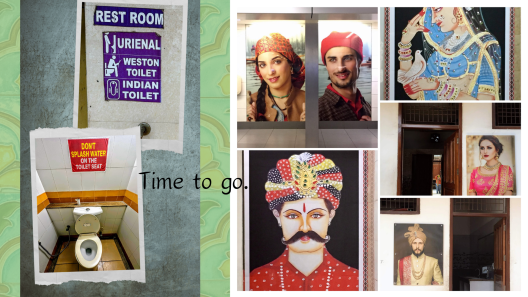
Of course, it can still be a work in progress in rural areas. We enjoy the creative bathroom signs, but still keep a supply of paper napkins in our pockets. In a roadside restaurant a few weeks ago, we were proudly waved to the bathrooms, only to discover that they were the traditional (hole) variety, with one stall closed and locked. When we asked about western toilets, there was a frantic search for the key to the locked stall which was clearly not for general use. After multiple keys were produced, the western toilet was unlocked with a flourish.

When we saw cheerful groups of young volunteers bagging trash in Delhi, their enthusiasm for a cleaner India was clearly evident. There are steep fines in some cities like Mumbai for even carrying a single-use plastic bag!
Another thing that has changed in the past few years is the intensity of demand for pictures with foreigners. The polite and even shy requests for photos we encountered our first trip years ago have grown into insistence that borders on stalking.
At popular sites, we can barely get through the throngs taking their own pictures, almost always blocking out and frequently facing away from the treasures displayed. The poor guards’ whistles sound nonstop as they attempt to keep selfie-takers from hanging off or climbing the sculptures for a better view of themselves. But apparently the only thing that could distract them is the one missing piece for their digitized composition: women in western dress. “Selfie Madam?” is the incessant refrain following us across India.
We’ve gotten used to this plea and have developed a rule: we only pose with children. But…there are a LOT of adorable children in India…

Of course, some things haven’t changed yet. In cities, beggars still knock on your car window and hold up their children. If you work up the nerve to cross a street in any major city, you still have to look in ALL the directions, watch out for cows, goats, camels, and the occasional elephant, and be careful where you step. Crossing the street in Mumbai is still an act of blind faith.
India, as always, is a study in contrasts. High tech entrepreneurs building tomorrow’s apps will consult with a temple to discover the most auspicious timing for their product release. Visiting foreigners still shouldn’t drink the water, but they can buy some of the most high tech products on the planet. When it comes to medical access, India has implemented a sweeping coverage that puts most of the world to shame, and their sophisticated expertise has elevated it to a preferred destination for medical tourists, myself included.
India has been building a world-class medical system, which has fed a growing medical tourism industry. A few months before our trip last year, some rogue blood vessels on my middle finger decided to party, and their shenanigans produced a growth that looked a lot like a misplaced manly appendage. While this could have led to all kinds of interesting personal developments, I really wasn’t up for seeing it waving as I tried to type. My doctor said it could be months before the NHS could remove it, so my choices boiled down to paying a private doctor here in Scotland a shedload of money for removal of my embarrassing mini-member, or going to a doctor while in India.
Jaya activated the Indian Mother Network, and found a relative: her husband’s cousin’s mother-in-law’s niece is what I think she said, but actually I lost track. With that close family tie, Jaya was told to just bring me in, no appointment needed.
Doctor Shobana S, a well-known dermatologist dressed in a beautiful sari, greeted me serenely from behind her desk. A few minutes later, my unwanted mini-appendage was history. Cost for the procedure, including her consultation fee and prescriptions was less than dinner and a movie back home. For the rest of our trip, this became our new monetary unit. (As in, “How many fingers is that statue?” Or “That guide wanted half a finger, but Jaya bargained down to just a third.”)
So what was the biggest change we’ve seen in India over the past decade?
Was it the delicious new foods?
Was it the time we were famous for 15 minutes?
Like everyone else, I’ve wondered what being a celebrity would feel like. Well, I found out. And you can too. Here’s all you have to do:
Step 1: Go to the most rural part of India you can (kind-of) pronounce.
Step 2: Be a western foreigner. Bonus points for being female.

It was Republic Day, and we stopped to watch school children celebrating. We posed for selfies with almost every child in the school, and following a quickly organized school photo with us in the center, we finally left, with the entire school gathered to wave us off.
Was it the once-in-a-lifetime experiences?
Was it the exotic wildlife and birds we observed?
The incredible museum collections preserving India’s heritage for the world?
Maybe it was the incredible art, music, dance, and theater?

We stumbled across a street art fair in Mumbai. We watched a young woman in the desert dance on spikes while balancing a flaming pot on her head. We saw demons vanquished in Katakali theater, saw ancient martial arts as about a dozen VERY fit Kalaripayattu performers proceeded to beat the tar out of each other using an array of weapons, much of it actually on fire. We were given a personal tour of a heritage puppet theater.

When a friend of Jaya’s heard the music festival we’d arranged our trip around was cancelled, she invited world-famous sitar musicians to give a private concert in her home.

When we arrived at a supposedly “free” concert only to find that all tickets were gone, the young crew at the gate insisted we take their tickets to an unforgettable show under the stars.
Or maybe it was the historic sites — palaces, forts, temples, and incredible achievements over millennia?

1. Taj Mahal, Agra
2. Shuchindram Temple, Tamil Nadu
3. Flora Fountain, Mumbai
4. Qutab Minar, Delhi
5. Zoroastrian Temple, Mumbai
6. Gateway of India
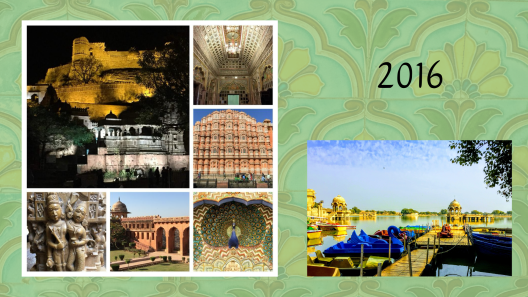
(Clockwise from top left) 1. Kumbhalgarh, Rajasthan
2. City Palace, Jaipur
3. Hawa Mahal, Jaipur
4. City Palace, Jaipur
5. Jaigarh Fort, Jaipur
6. Jaisalmer, Rajasthan
Large photo: Marajah’s Lake, Jaisalmer Rajasthan

(Clockwise from top left) 1. Lotus Mahal, Hampi
2. Halebeedu, Karnataka
3. Hampi, Karnataka
4. Badami, Karnataka
5. Belur, Karnataka
6. Hampi
(large: Dancing Shiva, Badami Cave Temples || Badami 1

1. Vishnu at Rani Ki Vav, Modhera, Gujarat
2. Sun Temple, Modhera
3. Dholavira, Gujarat
4. Sun Temple
5. Stepwell (Rani Ki Vav)
6. Stepwell (Rani Ki Vav)
Large: Diu, Dadra and Nagar Haveli and Daman and Diu
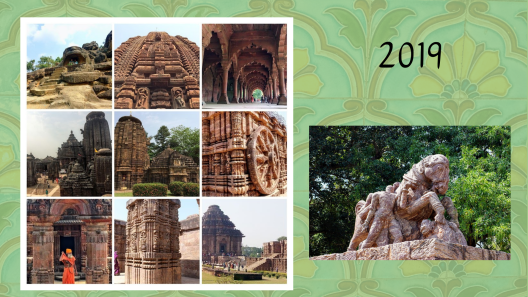
Top row
1. Udayagiri Caves, Bhubaneswar
2. Mukteswara Temple, Bhubaneswar
3. Diwan-i-Aam, Delhi
Middle row
4. Lingaraj Temple, Bhubaneswar, Odisha
5. Kedar Gouri, Bhubaneswar, Odisha
6. Konark, Odisha
Bottom Row
7 . Kedar Gouri, Bhubaneswar, Odisha
8. Konark, Odisha
9. Konark, Odisha
Large: Konark

1. Airavatesvara Temple, Darasuram (near Thanjavur) 2. Ajanta Caves, Maharashtra
3. Ajanta Caves, Maharashtra
4. Ajanta Caves, Maharashtra
5. Ajanta Caves, Maharashtra
Large: Ellora Caves
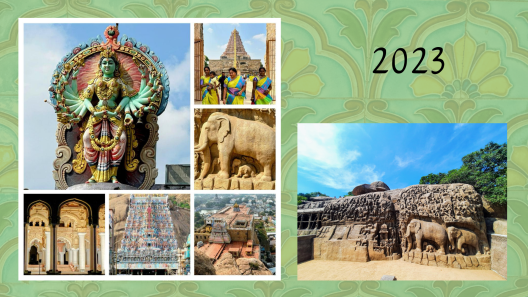
(Clockwise from top left) 1. Shree Thillai Nataraja Temple, Chidambaram
2. Arunchala Ramana Mahar Gangaikondacholapuram
3. Mamallapuram Temple
4. Rock Fort Temple, Thanjavur
5. Sri Arulmigu Subramaniyan Temple, Tanjavur
6. Thirumalai Nayakkar Palace, Madurai
Large: Descent of the Ganges (Mahabalipuram)

(Clockwise from top left)
1. Lakefront, Bhopal
2. UNESCO World Heritage Buddhist monuments,3rd century BCE to the 12th century CE, Sanchi
3. 100,000 year old cave paintings at Bhimbetka rock shelters
4. Tribal dancers at Literature & Arts Festival, Bhopal
5. Tribal Museum, Bhopal
6. Mahakal Corridor, Ujjain
large: Unity Statue
As we visited more states each year, seeing change in India showed us the changes in ourselves. Walking the same place and seeing the same things as our ancestors millenia ago showed us our common heritage.And of course, observing changes in India over the past decade points out the ways we’re changing too. We know the chance to travel together as friends is a rare and fragile thing, and that the passing years, the dangers of pandemics and wars and time mean that each day of every trip is a gift we have to welcome with thanks and laughter.

Over the past decade, our most common refrain became, “Has anyone seen my …?”
“Thingie” is now an all-purpose noun. The ever-kind Indians we meet are even more solicitous. The stairs seem higher, both the sun and the food a bit hotter, and our energy runs out long before either our day or our money do.
As we’ve toured the marvels left in India by past generations, I’ve often wondered what we will leave behind for our descendants to marvel about.
We tell people back home, “If you want to see an India full of stunning historical and artistic treasures, you’re in luck. You’ll find toilets along the way, on-demand drivers to get you there, and familiar American fast food choices that can’t begin to compare with the delicious foods of India. You can get a world-class medical procedure at bargain prices, amazing food, and all the photos with total strangers you ever/never wanted. And most of all, you’ll get to spend time in a country full of the 1.4 billion nicest people you’ll ever meet. And that one mean one who got us kicked out of the temple that time…”
Change? In India or in us?
Well, two little girls from opposite sides of the States and one from India can grow up, attend the University of Chicago, and share a flat. Half a century later, they can all meet up in India every year, to travel, search for toilets, explore antiquities, eat parathas, and watch the future unfold.
Only now they can pay for it all using their phone-thingies. If they can just remember where they put them…
If you would like to hear more about our travel adventures, like that time we were kidnapped in Bangalore, joined an archeological dig as they made an amazing discovery, or did NOT race our camels across the desert, please check out our best-selling books on Amazon.
PS: if anyone would like to point out the mistake(s) in my lists of India visits by year, I will send the first correct one a copy of one of our books.






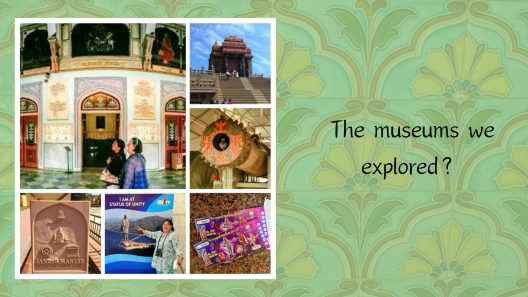

It sounds like it was a wonderful series of adventures!
LikeLiked by 2 people
Somehow, each trip seems better than the one before!
LikeLike
Thanks for this very enjoyable and informative retrospective of your Indian visits. It’s wonderful to have such friends and adventures together. 😊
LikeLiked by 2 people
The things we see are wonderful, but you’re right — it’s the friends I’m seeing them with that makes the magic.
LikeLiked by 1 person
What super experiences!
LikeLiked by 2 people
Every time we do one of these trips, I’m in awe of how lucky I am!
LikeLiked by 1 person
Me too. I definitely need to go again.
LikeLike
I love that you friendship has grown and continues to grow with each new adventure.
LikeLiked by 2 people
We know we’re lucky, and also that time is passing. So we have to make the most of every trip.
LikeLike
Wonderful post, Barb, what fantastic experiences you have had.
LikeLiked by 2 people
We are constantly amazed at the chance to see places and things that no other westerners get to experience. We are so lucky!
LikeLiked by 1 person
I love reading about your exploits in india, they never fail to make me laugh. and feel more normal about myself )
LikeLiked by 2 people
What an incredibly nice thing to say!Coming from you, I’m so flattered!
LikeLiked by 1 person
Great photo! ^^;
LikeLiked by 1 person
I can’t take credit for the brilliant photos. They (and about ten thousand others) were taken by my travel companions, Janine and Jaya.
LikeLike
What a travelogue, Barb, with your great sense of humor. I think both India and the three of you have changed – inevitable! Although some of the colorful views may be gone, I think India has come a long way! But how nice you can still make that journey together, with Jaya, the cruise director!
LikeLiked by 2 people
We were feeling so smug about how much we have seen in India. Then we made the little map with the pins for the places we’ve visited, and we realized we have barely scratched the surface of all there is to see and do in India. Clearly, the three of us will need to live until we’re about 150 years old!
LikeLiked by 1 person
Thanks for another colourful visit. I loved seeing those camels ambling gracefully down the road.
LikeLiked by 1 person
You’re so right! It’s amazing for us to see all the changes and technology in India, but also still see nomads with their camels.
LikeLiked by 1 person
You should write a book. Oh you have! I’ll have to check them out. Quite a change from Scotland I would assume!
LikeLiked by 1 person
The change in the weather alone would be enough! (It’s below freezing here in Scotland, there’s a huge storm, and the waves are pounding over the road. In India it’s warm and sunny.)
LikeLike
This piece is just brimful of love for the country, its people and your friends. It’s so funny but I also find it very moving. I’ll be buying the book if there is one.
LikeLike
Barb, this was ‘the best of the best’ of your India travel posts, plus some bonus photos (like you standing on the toilet to get cell phone reception). Don’t you love how your memory keeps you at 25 or 30, and you body has a different idea? Your humor makes life smile.
LikeLike
Pingback: India: where nothing changes. Except for… everything. #India #travel #humor | In the Net! – Pictures and Stories of Life
It sounds irresistible and makes me wonder why I’ve never made it there. Lack of loo paper is no excuse, is it? That can happen here too, though I don’t recall standing on a toilet seat to get a WiFi connection.
LikeLike
What fun and made so much better with good friends. May the adventures continue. The photo of you looking for a WiFi signal in the bathroom is priceless.
LikeLike
I hope there will be a Your Camels Are Here #3!!!! x
LikeLike